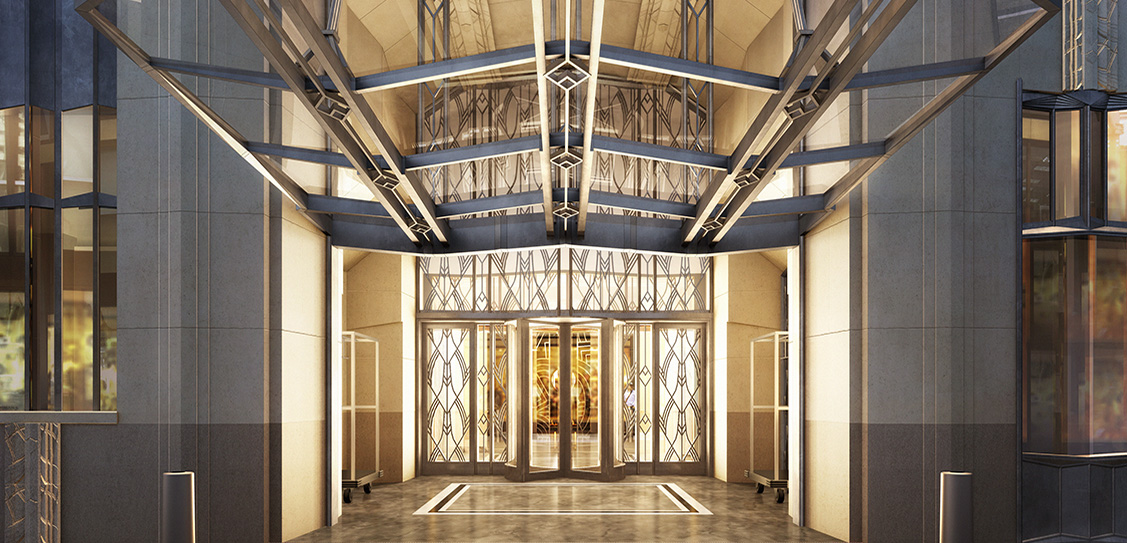Considering the current drive for sustainable practices across all industries and with the volume of construction waste generated worldwide every year predicted to nearly double to 2.2 billion tons by the year 2025, many developers are revamping old buildings in a practice known as ‘adaptive reuse’.
Bypassing the wasteful process of demolition and construction - and in turn, reducing the carbon payback period in comparison to new construction - adaptive reuse takes advantage of existing structures and transforms them into contemporary spaces which satisfy the modern-day consumer. The practice further empowers cities to make more efficient use of space amid the current increased demand for housing, while still preserving the historic character of the built environment.
A high profile and anticipated example of where this practise is being employed is Macklowe Properties’ repurposing and restoration of the former Irving Trust Building and Art Deco landmark - One Wall Street. Currently undergoing a transformation into 566 studios to four-bedroom apartments in the centre of Downtown, Macklowe is retaining the limestone façade and impressive interiors including the ‘Red Room’ that features a 9,000 square foot, triple-height floor-to-ceiling mosaic by muralist Hildreth Meière which will be transformed into a retail space.
We spoke to Lilla Smith, the Architecture and Design Director at Macklowe Properties who is overseeing this iconic transformation and asked about the challenges and rewards that come with repositioning a building of this magnitude.
From an architectural perspective, what are the challenges in repurposing such a building, rather than pulling it down (even if planning permission allowed its demolition), and starting again with a blank site?
Marrying the old and the new is always a challenge when repositioning historic buildings. Maximizing efficiency in residential and retail floors is usually very difficult. For example, a major process of One Wall Street’s conversion involved the demolition of 30 existing elevators and interior stairs and the reconstruction of new elevator shafts, all centrally located to optimize layouts, light and air for each of the buildings 566 units. The phasing of this demolition had to be carefully orchestrated as new stairs had to be constructed before existing stairs could be removed, which in turn allowed for new elevator shafts to be built and new window openings to be created facing East and South looking towards New York Harbour. With this new infrastructure now in place, we are past the logistical hurdles and are focused on building out the residences and amenity spaces.
How were you able to control waste during this process and what are the challenges in doing so?
There is nothing more compelling from an environmentally sustainable perspective than to recycle and re-use an existing building. By restoring One Wall Street, the bulk of demolition and construction waste that would have been generated with a new structure was avoided. We saved on the embodied energy required for excavation and foundations thereby eliminating the need for removal of demolition debris or the use of thousands of explosive sticks for rock breaking. On the superstructure, we avoided the need to pour thousands of cubic yards of new concrete or install tons of rebar and structural steel.
With this redevelopment, we have kept the existing dimensional limestone façade and backup brick wall, cleaned the exterior and performed restoration work so that our building looks like it did upon original completion. The 2,500 existing windows, which were recently replaced by the previous building owner, BNY Mellon, are energy efficient, insulated glass units that are undergoing a thorough maintenance program so that the windows, and their hardware and balances will function like new.
What are the cost implications of such a project – have there been any savings made by refurbishing the building rather than typical demolition and reconstruction?
Due to the comprehensive nature and the logistic complexity of this particular adaptive reuse project, there are limited cost savings realized in the conversion. However, by leveraging and elevating the prominence of the location, the pedigree of the architect and the significance of the design, significant value will be created.
As an example, in the restoration of the building’s historic ‘Red Room’, which originally served as both the building’s ground-level reception room and the principal banking hall of the Irving Trust Company, maintaining the historical integrity of the room was paramount. Refurbishing the 9,000 sq. ft. of glass mosaic required sourcing materials that compliment and preserve the existing finishes and sourcing resourceful mosaicists who had the skillset and experience to handle the work on the walls and ceiling. The total restoration cost approximately $1million and over 3,000 working hours.
We also spent a great deal of effort removing and salvaging the existing Art Deco ornamental metal elevator door panels from the 1930's landmark building - these are now being repurposed by our retail tenants as decorative wall elements in their interior fit out.
How does adaptive reuse work in the US? How does it differ from a more traditional architect approach in terms of planning, design challenges?
From a permitting and approval standpoint, the conversion of this landmarked building from commercial to residential and retail use required multiple city agencies and community groups to agree on the redevelopment proposal. Macklowe Properties purchased the site in September of 2014 and in December of 2016 obtained the necessary approvals from the Landmarks Preservation Commission, Board of Standards and Appeals, Department of City Planning, Transit Authority, and the Department of Buildings. Acquiring entitlements for existing buildings with historical significance is generally much more difficult then executing a new ground-up project. In addition, historic buildings situated in very dense urban areas pose a significant logistical challenge for the construction manager, specifically as it pertains to staging the site, loading and distribution of supplies and people throughout the building.
As the US building stock gets older, more and more buildings and neighbourhoods receive historic designations by city, state and federal preservation agencies. Over the last few decades, the conservation movement has grown stronger, creating a variety of strict rules and regulations pertaining to historic preservation standards and major alterations that need to be met prior to receiving an approval to execute an adaptive reuse project. In addition, the sustainable building movement has impacted local building codes, requiring historic adaptive reuse buildings to meet modern energy efficiency standards, as well as life-safety, egress and accessibility for the disabled.
Some design and construction challenges involved in this particular project, revolved around creating prime retail space at the lower portion of the non-landmarked Annex Building and adding five floors to the top of the south tower. For retail tenants, we removed the third-floor slab and several columns to create a dramatic, double height, open floor plate. We transferred the available floor area to the top of the Annex and built four stories of residences and one additional floor of residential amenities with sweeping views of the New York Harbour and the Statue of Liberty. The five-floor addition required reinforcing the columns below, introduction of concrete shear walls and the use of cobiax slabs, a Swiss made bi-axial voided reinforced concrete slab system, that reduces dead load and volume of concrete. The result of this innovative engineering solution is a more efficient and sustainable alternative to conventional design and construction.



